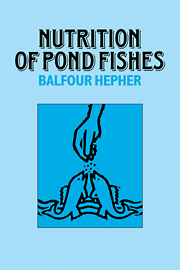Summary
The yield of fish per pond area or per culture unit, and thus the profitability of fish farming, depends to a large extent on the amount of supplementary feed used. The more intensive the aquaculture system, the greater the importance of supplementary feeding, and the greater the proportion of the feed costs to total production costs. According to Collins & Delmendo (1979) the cost of supplementary feed in a flowing water system and in cage culture can reach 56.3–56.8% of the total production costs. Cost of feed in pond culture can also be high. According to calculations made by the Fish Breeders Association of Israel (September 1985, personal communication) the feed costs in a polyculture pond farm of an average yield of 3.5 t/ha, where common carp constitute about 50% of the yield, have reached 30.6% of the total production costs. This included depreciation and interest; when these items were excluded cost of feed was 37.0% of the direct total production costs. This emphasizes the importance of determining the optimum level of feeding. Feeding too little will result in the utilization of most of the feed for maintenance. Conversely, feeding too much will result in a low utilization rate and a waste of feed. In both cases feed conversion ratio, i.e. the amount of feed used for a unit gain in fish weight, will increase and the profitability of the fish farm will correspondingly decrease.
- Type
- Chapter
- Information
- Nutrition of Pond Fishes , pp. 1 - 2Publisher: Cambridge University PressPrint publication year: 1988



